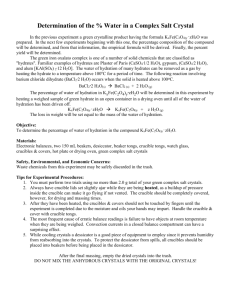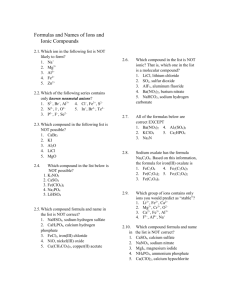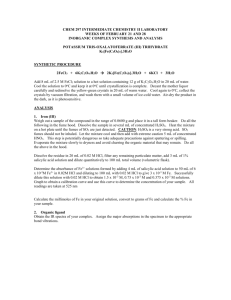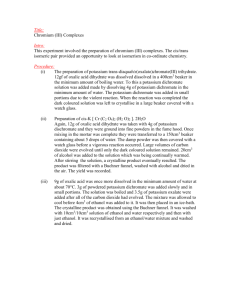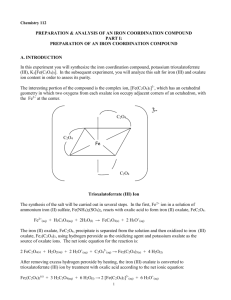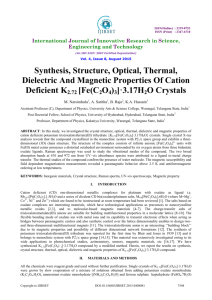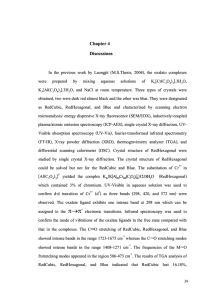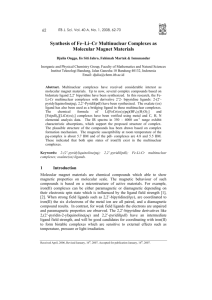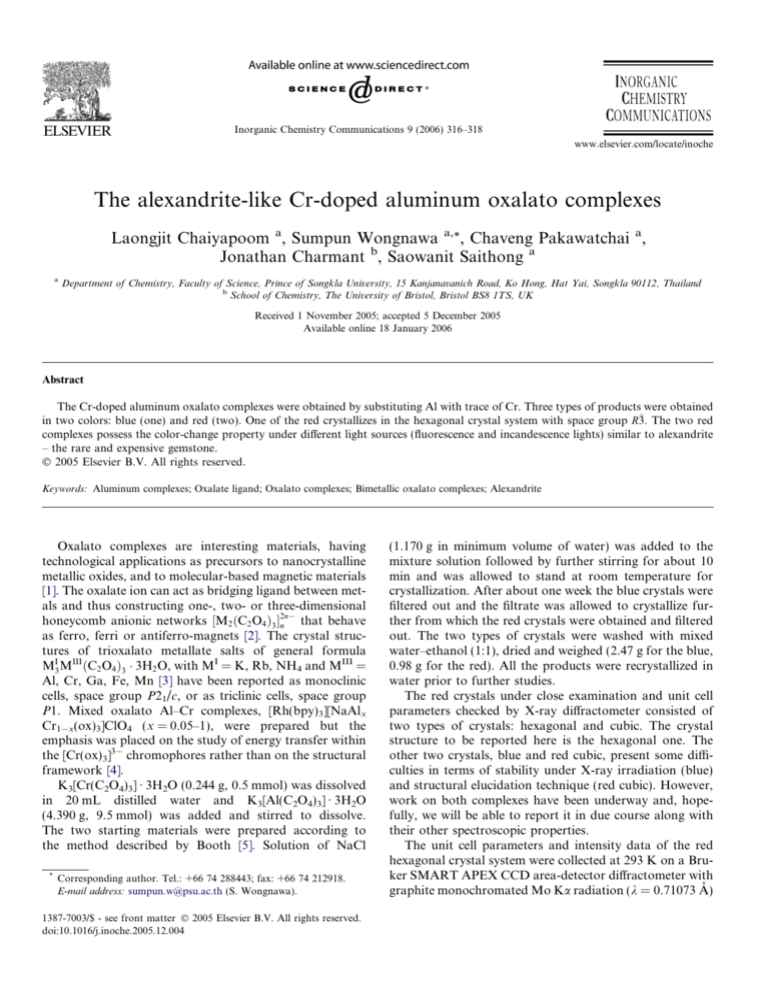
Inorganic Chemistry Communications 9 (2006) 316–318
www.elsevier.com/locate/inoche
The alexandrite-like Cr-doped aluminum oxalato complexes
Laongjit Chaiyapoom a, Sumpun Wongnawa a,*, Chaveng Pakawatchai a,
Jonathan Charmant b, Saowanit Saithong a
a
Department of Chemistry, Faculty of Science, Prince of Songkla University, 15 Kanjanavanich Road, Ko Hong, Hat Yai, Songkla 90112, Thailand
b
School of Chemistry, The University of Bristol, Bristol BS8 1TS, UK
Received 1 November 2005; accepted 5 December 2005
Available online 18 January 2006
Abstract
The Cr-doped aluminum oxalato complexes were obtained by substituting Al with trace of Cr. Three types of products were obtained
in two colors: blue (one) and red (two). One of the red crystallizes in the hexagonal crystal system with space group R
3. The two red
complexes possess the color-change property under different light sources (fluorescence and incandescence lights) similar to alexandrite
– the rare and expensive gemstone.
Ó 2005 Elsevier B.V. All rights reserved.
Keywords: Aluminum complexes; Oxalate ligand; Oxalato complexes; Bimetallic oxalato complexes; Alexandrite
Oxalato complexes are interesting materials, having
technological applications as precursors to nanocrystalline
metallic oxides, and to molecular-based magnetic materials
[1]. The oxalate ion can act as bridging ligand between metals and thus constructing one-, two- or three-dimensional
honeycomb anionic networks ½M2 ðC2 O4 Þ3 2n
that behave
n
as ferro, ferri or antiferro-magnets [2]. The crystal structures of trioxalato metallate salts of general formula
MI3 MIII ðC2 O4 Þ3 3H2 O, with MI = K, Rb, NH4 and MIII =
Al, Cr, Ga, Fe, Mn [3] have been reported as monoclinic
cells, space group P21/c, or as triclinic cells, space group
P1. Mixed oxalato Al–Cr complexes, [Rh(bpy)3][NaAlx
Cr1x(ox)3]ClO4 (x = 0.05–1), were prepared but the
emphasis was placed on the study of energy transfer within
the [Cr(ox)3]3 chromophores rather than on the structural
framework [4].
K3[Cr(C2O4)3] Æ 3H2O (0.244 g, 0.5 mmol) was dissolved
in 20 mL distilled water and K3[Al(C2O4)3] Æ 3H2O
(4.390 g, 9.5 mmol) was added and stirred to dissolve.
The two starting materials were prepared according to
the method described by Booth [5]. Solution of NaCl
*
Corresponding author. Tel.: +66 74 288443; fax: +66 74 212918.
E-mail address: sumpun.w@psu.ac.th (S. Wongnawa).
1387-7003/$ - see front matter Ó 2005 Elsevier B.V. All rights reserved.
doi:10.1016/j.inoche.2005.12.004
(1.170 g in minimum volume of water) was added to the
mixture solution followed by further stirring for about 10
min and was allowed to stand at room temperature for
crystallization. After about one week the blue crystals were
filtered out and the filtrate was allowed to crystallize further from which the red crystals were obtained and filtered
out. The two types of crystals were washed with mixed
water–ethanol (1:1), dried and weighed (2.47 g for the blue,
0.98 g for the red). All the products were recrystallized in
water prior to further studies.
The red crystals under close examination and unit cell
parameters checked by X-ray diffractometer consisted of
two types of crystals: hexagonal and cubic. The crystal
structure to be reported here is the hexagonal one. The
other two crystals, blue and red cubic, present some difficulties in terms of stability under X-ray irradiation (blue)
and structural elucidation technique (red cubic). However,
work on both complexes have been underway and, hopefully, we will be able to report it in due course along with
their other spectroscopic properties.
The unit cell parameters and intensity data of the red
hexagonal crystal system were collected at 293 K on a Bruker SMART APEX CCD area-detector diffractometer with
graphite monochromated Mo Ka radiation (k = 0.71073 Å)
L. Chaiyapoom et al. / Inorganic Chemistry Communications 9 (2006) 316–318
(at a detector distance of 6.0 cm) using SMART program
(Bruker, 2000). A fullsphere of the reciprocal space was covered by a combination of three sets of exposures; each set
had a different / angle (0°, 120°, 240°) and each exposure
of 10 s covered 0.3° in x. Raw data frame integration was
performed with SAINT (Bruker, 2000), with applied correction for Lorentz and polarization effects. An empirical
absorption correction by using the SADABS program (Bruker, 2000) was applied, which resulted in transmission coefficients ranging from 0.905 to 1.000. A total of 16191
reflections (2595 independent reflections, Rint = 0.0245)
were collected in the range 2.22° < h < 24.70°. This structure was solved by Direct methods using SHLLXTL-PC
V6.12 software package (Bruker, 2000) and refined by full
matrix least-squares method based on jFj with anisotropic
thermal parameters for all non-hydrogen atoms by using
XTAL3.7 program system [6]. The hydrogen atoms were
found by Fourier maps and refined isotropically. View of
the molecular unit of this complex is shown in Fig. 1.
17
The structure consists of discrete K½AlðoxÞ3 6 anions,
+
K cations, a Cl anion, and water molecules. The asymmetric unit of the complex contains four potassium atoms,
one chloride atom, one aluminum atom, three oxalate
ligands, and three water molecules. Chlorine atom and
one potassium atom (K1) lie on 3 axis, then the remaining
parts of the structure generated by this axis forming the
formula unit or the structure of K18{K[Al(C2O4)3]6}
Cl Æ 18H2O. However, there is a small amount of Cr in the
crystal structure which is in the same position as Al. The site
occupancies of Al and Cr are 0.97 and 0.03, respectively,
therefore, the molecular formula of the red hexagonal crystal may be written as K18{K[Al0.97Cr0.03(C2O4)3]6}Cl Æ
18H2O [7].
Fig. 1. The 50% thermal ellipsoid of core structure of K18{K[Al0.97Cr0.03
(C2O4)3]6}Cl Æ 18H2O complex molecule plot (all counterions, H2O, and H
atoms are omitted for clarity).
317
The potassium ion in the unit core structure,
17
K½AlðC2 O4 Þ3 6 , lies on 3 axis and is surrounded, in octahedral geometry, by six terminal oxygen atoms from six
oxalate ligands of six [Al(C2O4)3]3 anions as shown in
Fig. 1 with the K–O equidistances of 2.400(3) Å. One of
the oxalate ligands of [Al(C2O4)3] 3 unit acts as tridentate
ligand bonded to K and Al atoms whereas the remaining
two C2 O2
4 ligands bond to Al atom as bidentate ligands.
[Al(C2O4)3]3 unit has a distorted octahedral geometry
with the oxalate ligand bite O–Al–O angles of 84.4(1)°,
84.4(1)°, and 84.0(1)° for O1–Al–O2, O3–Al–O4, and
O5–Al–O6, respectively.
The three new complexes (two reds and one blue) readily dissolve in water yielding similar greenish violet solutions whose UV–Vis absorption spectra are almost
identical to that of K3[Cr(ox)3] Æ 3H2O (Fig. 2) indicating
the chromophore being responsible for the color in the
three solutions are the same as that in K3[Cr(ox)3] Æ 3H2O,
that is, the [Cr(ox)3]3 moiety. Based on the energy diagram of Cr3+ (d3), there are three spin-allowed transitions, namely, m1(4A2g ! 4T2g), m2(4A2g ! 4T1g(F)), and
m3(4A2g ! 4T1g(P)). For the [Cr(ox)3]3 these three transitions have been reported as: 571, 417, 263 nm for m1, m2,
m3, respectively [8]. Our solution samples also yielded the
same results (Table 1). The kmax of m3 transition is not
decisive as it overlaps with the p–p* transition of the oxalate ligand which occurs at ca. 300 nm [9]. The solid state
diffused reflectance spectra (Fig. 3) show the same pattern
as in the solution forms but on a closer look one can
detect a slight shift of the m1(4A2g ! 4T2g transition) peak
(Table 1) and a small difference in shape especially the
position of kmin of the trough at ca. 480–490 nm
(Fig. 3). The reason they appear in different colors in solid
state is due to slight change in the kmax of m1 peak and
kmin of the trough originating from slight different environment around the chromophore [Cr(ox)3]3 in solid
state. In Fig. 3, the spin-forbidden transition 4A2g ! 2Eg,
2
T1g, 2T2g is also discernible at 697 nm [10].
In addition, the two red crystals also show the colorchange property under different light sources: fluorescence
Fig. 2. UV–Vis absorption spectra of red cubic, red hexagonal, blue
complexes, and K3[Cr(C2O4)3] Æ H2O in aqueous solution. (For interpretation of the references in color in this figure legend, the reader is referred
to the web version of this article.)
318
L. Chaiyapoom et al. / Inorganic Chemistry Communications 9 (2006) 316–318
Table 1
Absorption bands of red cubic, red hexagonal, blue, and K3[Cr(C2O4)3] Æ
3H2O
change property is well known in the rare and expensive
gemstone alexandrite [12].
Complex
Acknowledgments
Phase
Absorption band (nm)
m3 + p–p*
m2
m1
Red cubic
Solution
Solid
299
263
419
421
572
571
Red hexagonal
Solution
Solid
299
257
424
419
579
567
Blue
Solution
Solid
299
269
419
421
572
579
L.C. would like to express her sincere thanks to the consortium of Postgraduate Education and Research Program
in Chemistry (PERCH) for financial support (scholarship
and research fund) and also to the Graduate School of
Prince of Songkla University for the Thesis Research
Fund.
K3[Cr(C2O4)3] Æ 3H2O
Solution
Solid
299
258
420
420
572
580
References
Fig. 3. UV–Vis absorption spectra of red cubic, red hexagonal, blue
complexes, and K3[Cr(C2O4)3] Æ H2O in solid state by diffused reflectance
method. (For interpretation of the references in color in this figure legend,
the reader is referred to the web version of this article.)
Fig. 4. The color-change red cubic crystals: dark blue under fluorescent
light, and reddish violet under incandescent light. (For interpretation of
the references in color in this figure legend, the reader is referred to the
web version of this article.)
and incandescence lights. Fig. 4 shows the red cubic crystals appeared as dark blue under fluorescence light but
reddish violet under incandescence light [11]. This color-
[1] H. Tamaki, Z.J. Zhong, N. Matsumoto, S. Kida, M. Koikawa, N.
Achiwa, Y. Hashimoto, H. Ökawa, J. Am. Chem. Soc. 114 (1992)
6974.
[2] F. Bérézovsky, A.A. Hajem, S. Triki, J.S. Pala, P. Molinié, Inorg.
Chim. Acta 284 (1999) 8;
L. Öhrström, G. Svensson, Inorg. Chim. Acta 305 (2000) 157;
B. Malézieux, R. Andrés, M. Brissard, M. Gruselle, C. Train, P.
Herson, L.L. Troitskaya, V.I. Sokolov, S.T. Ovseenko, T.V. Demeschik, N.S. Ovanesyan, I.A. Mamed’yarova, J. Organomet. Chem.
182 (2001) 637–639;
D. Armentano, G.D. Munno, J. Faus, F. Lloret, M. Julve, Inorg.
Chem. 40 (2001) 655.
[3] G. Delgado, A. Mora, V. Sagredo, Physica B 320 (2002) 410.
[4] M.E. von Arx, V.S. Langford, U. Oetliker, A. Hauser, J. Phys. Chem.
A 106 (2002) 7099.
[5] H.S. Booth, Inorganic Synthesis, 1, Mc-Graw-Hill Inc., New York,
1939.
[6] S.R. Hall, G.S.D. King, J.M. Stewart, XTAL3.6 System University of
Western Australia, 1999.
[7] This formula agrees with elemental analyses (%): K 25.91(25.99); Al
4.80(5.51); Cr 0.34(0.33); oxalate group 55.73(55.51); H2O
11.08(11.35). Calculated values are in parentheses. K, Al, Cr were
determined by ICP-AES, oxalate group by titration method, and H2O
by TGA. In addition, SEM/EDX was also used to check the purity of
this complex where only characteristic X-ray lines of C, O, Al, Cl, K,
and Cr were detected.
[8] F.A. Cotton, G. Wilkinson, Advanced Inorganic Chemistry, third
edn., Interscience Publishers, John Wiley & Sons, New York, 1972, p.
839; J.E. Huheey, E.A. Keiter, R.L. Keiter, Inorganic Chemistry:
Principles of Structure and Reactivity, fourth edn., Harper Collins
College Publishers, New York, 1993, p. 447. The value of m3 usually
was not available experimentally, the value shown here was obtained
by calculation.
[9] D.P. Graddon, J. Inorg. Nucl. Chem. 3 (1956) 308.
[10] T.D. Yager, G.R. Eaton, J. Chem. Educ. 56 (1979) 635.
[11] The photographs of only the red cubic crystals are shown here
because the crystals of the red hexagonal ones were too small for the
photograph to be taken.
[12] B.M. Loeffler, R.G. Burns, American Scientist, 64 (1976) 636;
Websites: http://www.gemsociety.org/WorldClass/alexandrite_101.
htm;http://www.natural-alexandrite.com.

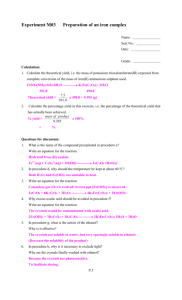
![[Zr(C 2 O 4 ) 4 ] 4](http://s3.studylib.net/store/data/006964769_1-29aedaf41342f4132b60bdeb351827c4-300x300.png)
